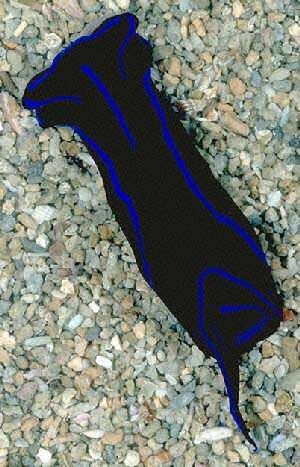
Chelidonura varians
Eliot, 1903.
Order: CEPHALASPIDEA
Family: Aglajidae
DISTRIBUTION
Found throughout the tropical Indo-West Pacific. Grows to about 7cm long.
PHOTO
Koumac, northern New Caledonia, October 1993. PHOTO: Bill Rudman.
This species is often mistaken for the very similarly coloured Philinopsis gardineri.
Read the messages below for interesting observations of Chelidonura feeding on flatworms. See also the General Biology Page for Chelidonura.
Reference:
• Eliot, C.N.E., (1903). Notes on some new or little-known members of the Family Doridiidae. Proceedings of the Malacological Society of London, 5(5): 331-7, Pl.13.
Rudman, W.B., 1998 (September 8) Chelidonura varians Eliot, 1903.. [In] Sea Slug Forum. Australian Museum, Sydney. Available from http://www.seaslugforum.net/find/chelvar
Related messages
Chelidonura varians - laying eggs in an aquarium.
April 21, 2010
From: Kim Schrier
Hi there,
I am hoping you can answer my question, as I can't seem to find the info I'm after on the net.
I have a Chelidonura varians quite happily eating flatworms I have in my aquarium and there are still a lot left. Today it laid eggs. Now I know that before opisthobranchs die they lay eggs, so is my Chelidonura going to die or do they lay eggs on a regular basis, even without a mate?
Hope you can help.
Thanks
Kim
kimschrier@gmail.com
Schrier, K., 2010 (Apr 21) Chelidonura varians - laying eggs in an aquarium.. [Message in] Sea Slug Forum. Australian Museum, Sydney. Available from http://www.seaslugforum.net/find/23530Dear Kim,
Some stressed or dying opisthobranchs do lay an egg mass - but in these cases the egg ribbon is usually malformed, often eggs are absent and only streaky bits of yolk are present. From this we consider the egg laying to be an uncoordinated action as the animal dies.
To lay viable eggs, an opisthobranch needs to mate with a second individual. However there is evidence that mating can occur quite a while before egg laying, the egg layer storing its partner's sperm in a special sac for some weeks. I am not sure how long sperm can be stored but it is possible your animal mated before you obtained it and is only now using the stored sperm.
If that is the case, hopefully you will not have to arrange a funeral in the near future.
Best wishes,
Bill Rudman
Re: Chelidonura varians in aquarium
December 3, 2009
From: Robin Jerome
Concerning message #22614:
Hi, just reading about seaslugs and especially Chelidonura varians which I host in one of my tanks for eating flat worms. Here is a link of the video I posted on youtube showing feeding:
http://www.youtube.com/watch?v=-wFujFhAdv0
Best regards.
Robin
Marseille, FRANCE
robby1@club.fr
Jerome, R., 2009 (Dec 3) Re: Chelidonura varians in aquarium. [Message in] Sea Slug Forum. Australian Museum, Sydney. Available from http://www.seaslugforum.net/find/22908Dear Robin,
Thanks for the interesting clip. if it has grown that large by eating such small flatworms, then it must eat an awful lot of them!
Best wishes,
Bill Rudman
Re: Chelidonura varians in aquarium
August 26, 2009
From: Bill Brown
Concerning message #21945:
In response to your questions about Chelidonura varians feeding:
1. Do they suck them in like a vacuum cleaner?
Yes they do - great to see when you have a flatworm infestation.
2. Also how many flatworms do they eat and at what rate? That is do they eat one and then have a sleep for a day? or do they crawl around hunting flatworms until they have a stomach full [5? 10?].
The latter - they hoover them up until full then sleep in mucus really like a vacuum cleaner. The flatworms try and make a break for it but it is too late
3. Any observations you can share would be very welcome.
From my tank experiences I would warn aquarium users if they have a Cleaner Wrasse. In my tank the fish attacked one of the similarly coloured slugs soon fater it was introduced and killed it. Also a Valentini Puffer fish pecked at one but to no ill effect. They have a habit of disappearing into rockwork. It is possible of course that have been eaten by crabs, fish etc However as I had a black nudi for months before I discovered it they can hide.
Bill Brown
UK
acehole007@gmail.com
Brown, W.R., 2009 (Aug 26) Re: Chelidonura varians in aquarium. [Message in] Sea Slug Forum. Australian Museum, Sydney. Available from http://www.seaslugforum.net/find/22614Dear Bill,
Thanks for these interesting observations on Chelidonura feeding. I had expected they would suck them in like you describe but after about 40 years I still haven't actually caught one feeding.
Best wishes,
Bill Rudman
Re: Chelidonura from Mayotte, Indian Ocean
January 30, 2009
From: Sylvain Le Bris
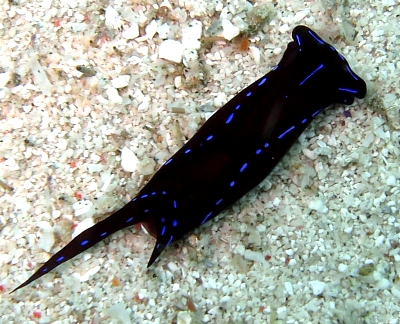
Concerning message #22110:
Dear Bill,
Here another Chelidonura from Mayotte. It differs from C. livida by smaller blue spots and a thinner body.
Locality: Nurserie, 10 m, Mayotte, Indian Ocean, 03 December 2008. Length: 2 cm. Photographer: Sylvain Le Bris.
Best regards
lebris.sylvain@gmail.com
Le Bris, S., 2009 (Jan 30) Re: Chelidonura from Mayotte, Indian Ocean. [Message in] Sea Slug Forum. Australian Museum, Sydney. Available from http://www.seaslugforum.net/find/22201Dear Sylvain,
Yes the body shape is rather different. I am pretty sure this is Chelidonura varians. but I have never seen one in which the blue line at the edge of the parapodia and the posterior part of the body has been broken into a series of streaks like this.
Best wishes,
Bill Rudman
Re: Chelidonura varians in aquarium
October 7, 2008
From: Beck None
Concerning message #11592:
I have recently got one of these blue velvet sea slugs [Chelidonura varians ]. From my research, people are saying they live about 3 months in a aquarium. Yes they are imported, but it took me months to find one in big als. I finally got one, dripped it and now its eating my flat worms, sleeping, spinning webs, and even has strange "floating" behaviour. I don't know much other that that. I'm learning more ...
I hope to find out what others experience with this slug are. I plan to enjoy it for a few months.
Beck None
carr.girl@hotmail.com
None, B., 2008 (Oct 7) Re: Chelidonura varians in aquarium. [Message in] Sea Slug Forum. Australian Museum, Sydney. Available from http://www.seaslugforum.net/find/21945Dear Beck,
I would be interested in hearing how you get on - or rather, how your Chelidonura gets on. The problem with specialist carnivores is what happens when they do their job and you have no flatworms left for them to eat. It would be interesting to have a description of how they actually eat the flatworms - do they suck them in like a vacuum cleaner? Also how many flatworms do they eat and at what rate? That is do they eat one and then have a sleep for a day? or do they crawl around hunting flatworms until they have a stomach full [5? 10?]. Any observations you can share would be very welcome.
Best wishes,
Bill Rudman
Chelidonura varians - mating behaviour
September 19, 2007
From: Kamal El Tawil
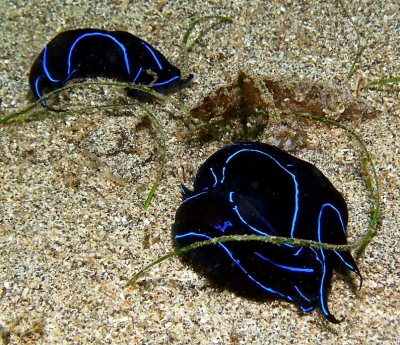
Dear Bill :
On a recent dive trip in Manado, I noticed two Chelidonura varians approaching each other and joining. A moment later a third one joined. Is this common behaviour ? Would you say that is mating ?
Locality: Bunaken marine park, Manado, 5 meters, North Sulawesi , Indonesia, Celebes sea, 13 August 2007, Sandy bottom. Length: 30 mms. Photographer: Kamal El Tawil.
How would you relate the second picture in Danny van Belle's message #19283? I think it involves more than two slugs too.
Kind regards,
Kamal el Tawil
www.coralworld.net
kamal@coralworld.net
El Tawil, K., 2007 (Sep 19) Chelidonura varians - mating behaviour. [Message in] Sea Slug Forum. Australian Museum, Sydney. Available from http://www.seaslugforum.net/find/20748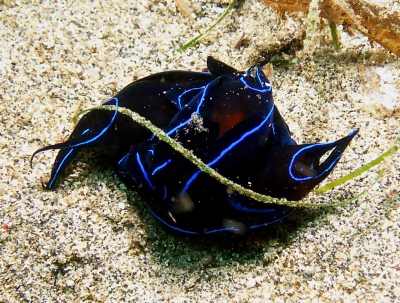
Dear Kamal,
Looking through earlier messages on this species, there are a number of observations of three animals 'pairing'. Like all sea slugs, species of Chelidonura are hermaphrodite, with fully functional male and female reproductive systems. In nudibranchs, the male and female organs open together on the right side of the body so for physical reasons only two animals can mate at one time, but when they do so they can act as both male and female at the same time. However in aglajids, like Chelidonura, and in Sea Hares, the male organ - the penis - is situated on the right side of the head, while the female opening is at the posterior end of the body on the right side. This means that when a pair mate, one usually acts as the female, and the other as the male. It also means that if there are more than two animals present they can form a mating chain with the one at the front acting as a female, the one at the back acting solely as a male, but the one[s] in the middle can act as both.
This is discussed more fully on the Mating Chains Fact Sheet. In the messages attached to that Fact Sheet you will see a number on what has been called the Sea Hare Love Drug which is a chemical signal Sea Hares produce when mating. It is possible that aglajids produce a similar chemical signal which would explain why two animals together can quickly attract a third - or more.
Best wishes,
Bill Rudman
Philinopsis gardineri? from the Red Sea
July 26, 2007
From: Dany Porras
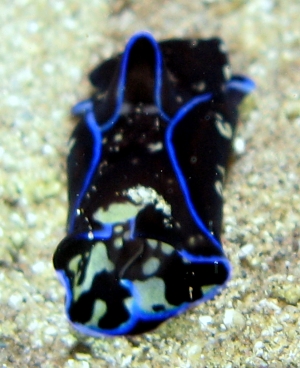
Hi!
We took this picture in the Red Sea. We thought we had enough pics of Philinopsis gardineri already, so we didn't mind that this one was not very good. turned out that the slug was slightly different from the others. Is it still P. gardineri?
Locality: El Quseir, 10 m, Egypt, Red Sea, 28 Feb 2007. Length: 50 mm. Photographer: Sven Peks.
Thank you for your help!
Dany Porras and Sven Peks
danyporras@gmx.de
Porras, D., 2007 (Jul 26) Philinopsis gardineri? from the Red Sea. [Message in] Sea Slug Forum. Australian Museum, Sydney. Available from http://www.seaslugforum.net/find/20268Dear Dany,
From the shape of the head and the long rounded crest on the back of the head shield which we can see sticking up in the middle of your photo, this is not Philinopsis gardineri. My guess is that it is the very similarly coloured Chelidonura varians. It usually does not have any white patching on the body so it may be an unnamed species, but we would need to know something about its anatomy and would need to find out whether white patching like this was just a local colour variation or not. If by chance you have a photo showing its 'tail' it would at least confirm it was a Chelidonura.
Best wishes,
Bill Rudman
Chelidonura varians - strange behavior
June 22, 2007
From: Erwin Kodiat
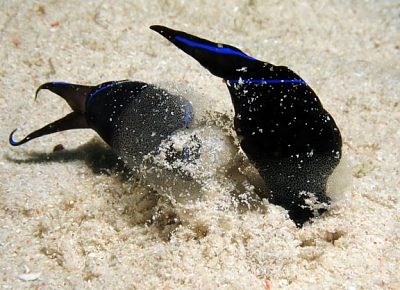
Concerning message #15560:
Hi Bill,
I observed a strange behavior of two Chelidonura varians I encountered in Sangalaki, East Borneo. Were they digging the hole on the sand? Was it for protection or feeding behavior? Thanks in advance.
Locality: Sangalaki Island, 15 meters, East Borneo, Sulawesi Sea, 28 May 2007, Sandy. Length: 3 cm. Photographer: Erwin Kodiat.
Erwin Kodiat
info@nudipixel.net
Kodiat, E., 2007 (Jun 22) Chelidonura varians - strange behavior. [Message in] Sea Slug Forum. Australian Museum, Sydney. Available from http://www.seaslugforum.net/find/20031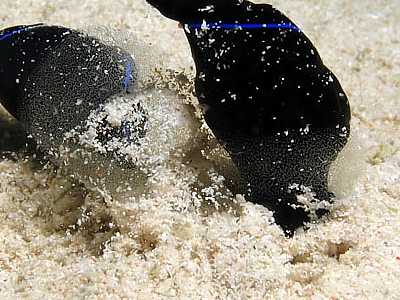
Dear Erwin,
Your photo reminds me of that great Olympic sport - 'synchronised swimming'!
This message follows on from your last which showed mating. In the close-up alongside I have slightly oversharpened your image so you can see that both animals have a mucous layer, filled with little white specks, wrapped around their heads. The white specks are eggs, and the animals are in the process of making their bubble-shaped egg mass which they anchor in the sand with a long mucous thread - which explains why you thought they were digging a hole. I have never seen a pair laying egg masses closely together like this, but I must say egg-laying it is not something I have seen often.
There is an earlier photo on the Forum of one laying an egg mass in an aquarium [message #9667] and photos of those of the related Philinopis taronga [message #11633] and Philinopsis cyanea [message #15333].
Best wishes,
Bill Rudman
Chelidonura varians from Bali
January 26, 2007
From: Danny Van Belle
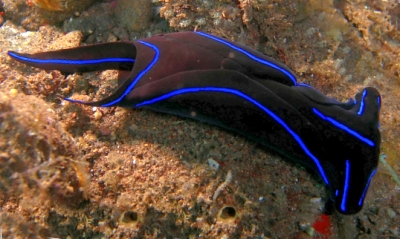
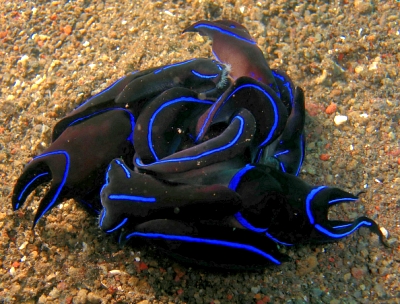
Dear Bill,
Chelidonura varians is very common around Bali -especially Tulamben area - but I also saw many on a discovery dive near the northeast side of Bali. I observed them mating but also producing the egg mass which was left behind on the sand.
Locality: Tulamben - Bali, 15 m, Indonesia, Indian ocean, 01 aug 2006 / 18 july 2006, Sand area behind the reef. Length: 5 cm. Photographer: Danny Van Belle & Anja Flick.
Danny Van Belle
danny.van.belle@skynet.be
Danny Van Belle, 2007 (Jan 26) Chelidonura varians from Bali. [Message in] Sea Slug Forum. Australian Museum, Sydney. Available from http://www.seaslugforum.net/find/19283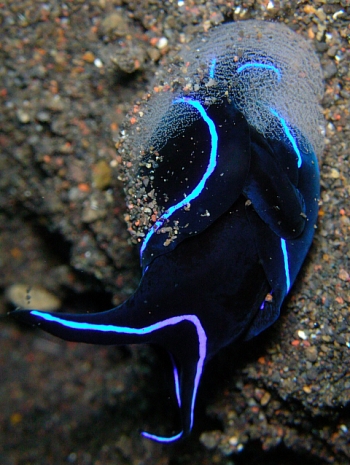
Dear Danny,
Thanks for these nice photos - it is a spectacularly coloured species. -- The egg mass of species of aglajid, when complete, is a sphere of jelly anchored in the sand with a long string of mucous. The string of eggs inside the jelly sphere forms a spiral. I often wondered how they did this - clearly it didn't just pop out ready made - unitl I discovered them doing much what we can see in your lower photo. The string of eggs, with a mucus coating, is pushed out of the genital opening and then wrapped round and round the head forming the spiral. When the string is complete, the head is withdrawn, the gap where the head came out is closed and the anchor string is dragged down into the sand.
Best wishes,
Bill Rudman
Chelidonura varians from sthn Queensland
May 4, 2006
From: Ian Banks
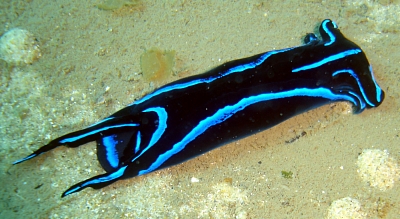
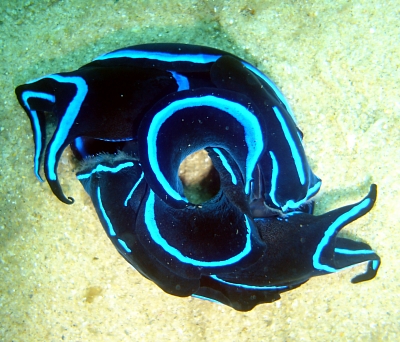
Bill,
I didn't find the Variable Chelidonura [Chelidonura varians ] on your site so have sent these photos taken just off the South-West Wall of the Gold Coast Seaway, inside the broadwater. From the southern end of the rock wall along for 100 metres parrallel to the wall I saw these out wandering on the sand, at least 20 all up. I guess it was mating time as I passed 4 couples forming circle patterns. Haven't observed them at any other time.
Locality: South-West Wall, Gold Coast Seaway, 5 metres, South-East QLD Australia, Pacific Ocean, 27 May 2005, Sandy Bottom. Length: 8cm Approx.. Photographer: Ian Banks.
Regards
Ian
ianbanks@bigpond.com
Banks, I.W., 2006 (May 4) Chelidonura varians from sthn Queensland. [Message in] Sea Slug Forum. Australian Museum, Sydney. Available from http://www.seaslugforum.net/find/16517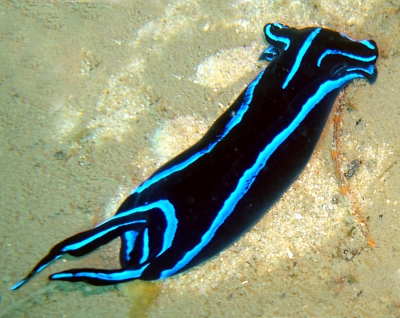
Dear Ian,
Thanks for the photos. We have a few of this species on the Forum but I always welcome a few more, as you never know what interesting feature the photos may show. For example, sometimes photos can show a peculiar colour variation or a huge geographical range extension.
I guess you couldn't find the species because I don't use common names like 'Variable Chelidonura '. Have a look at my Fact Sheet on common names to see why. In fact I just had a look at the original description of this species and Charles Eliot, who named it, gives no reason for calling it Chelidonura varians and doesn't mention any noticeable variability in the species, In fact it shows very little variability in colour pattern so I have no idea why Eliot thought 'varians' was an appropriate name. I guess you got the name from Neville Coleman's book. I am afraid that just translating the scientific name to English doesn't always make sense. Some people say they prefer common names because they don't know how to pronounce scinetific names. Well in this case you have to pronounce the difficult word 'chelidonura' in the common name so surely 'varians' would be no hurdle. I always recommend using the scientific name - it means anyone anywhere in the world knows what you are talking about
Best wishes,
Bill Rudman
Mating Chelidonura varians
January 16, 2006
From: Erwin Kodiat
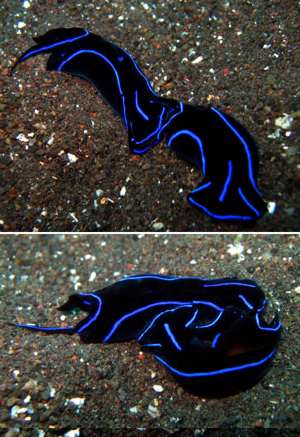
Hi Bill,
Here are some photos of mating Chelidonura varians. This sequence was taken from the beginning until end.
Locality: Tulamben, Bali, Indonesia. Lombok Strait. Depth: 13 metres. Length: 5 cm. 4 January 2006. Sandy. Photographer: Erwin Kodiat
Erwin Kodiat
ungu@terong.com
Kodiat, E., 2006 (Jan 16) Mating Chelidonura varians. [Message in] Sea Slug Forum. Australian Museum, Sydney. Available from http://www.seaslugforum.net/find/15560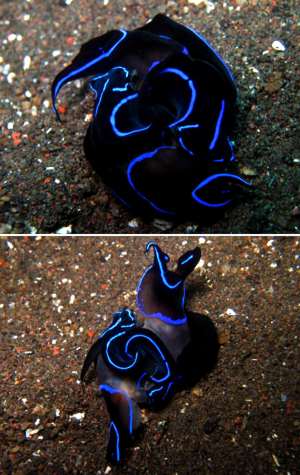
Dear Erwin,
Thanks for these. I always hesitate to post photos of Chelidonura varians, as this is the species many aquarium keepers want to buy to rid their tanks of flatworms. I'm afraid photos like this make them think it is a common species and new postings usually lead to a number of emails, asking where they can obtain specimens. I don't post these requests I as don't want to encourage the trade.
Best wishes,
Bill Rudman
Chelidonura varians from Bali
December 6, 2005
From: Erwin Kodiat
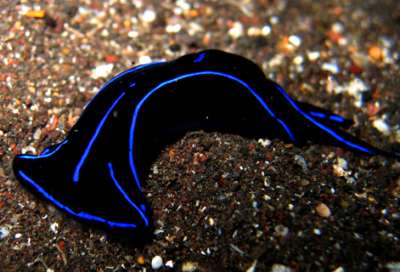
I encountered this Philinopsis gardineri in Bali (USS Liberty shipwreck)
Locality: Tulamben, Bali, Indonesia. Lombok Strait. Depth: 30 metres. Length: 4 cm. 15 November 2005. Sandy. Photographer: Erwin Kodiat
Erwin Kodiat
ungu@terong.com
Erwin Kodiat, 2005 (Dec 6) Chelidonura varians from Bali. [Message in] Sea Slug Forum. Australian Museum, Sydney. Available from http://www.seaslugforum.net/find/15401Dear Erwin,
It's very easy to confuse Philinopsis gardineri with Chelidonura varians. This one is Chelidonura varians while the one in your other message [#15398] is Philinopsis gardineri. Species of Chelidonura are usually easy to distinguish externally by their long tapering 'tails'
Best wishes,
Bill Rudman
Chelidonura varians mating
February 14, 2005
From: Mary Jane Adams
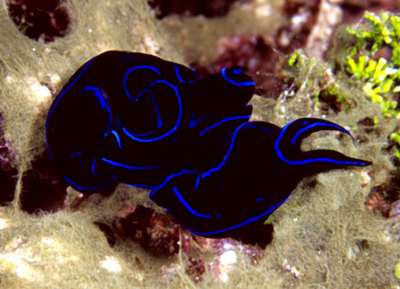
Hi Bill,
It's great to have the Forum back. Thanks for everything you have done to further the understanding of opisthobranchs for all of us out here in cyberland.
Here is a picture of Chelidonura varians mating behaviour. This is another case of three's a crowd. The slug on the right was crawling around the copulating pair, apparently trying to find an opening. It was completely ignored by the happy couple who were completely wrapped up in each other.
Locality: Uama Is. Milne Bay Province, Papua New Guinea Pacific Ocean. Depth: 7 m. Length: about 40 mm.14 January 2005. Coral reef. Photographer: Mary Jane Adams
Best regards,
Mary Jane
divepng@yahoo.com
Adams, M.J., 2005 (Feb 14) Chelidonura varians mating. [Message in] Sea Slug Forum. Australian Museum, Sydney. Available from http://www.seaslugforum.net/find/13145Dear Mary Jane,
I'm glad to have the Forum running again. There are still a few things to fix up but hopefully that won't take long. Concerning the unhappy third Chelidonura - perhaps it was trying to initiate a mating chain which is often seen in both sea hares and aglajids.
Best wishes,
Bill Rudman
Chelidonura varians in aquarium
December 4, 2003
From: tlp
Hi,
After managing to locate a few of these slugs [Chelidonura varians] and introducing them into my reef tank - they seem to have disappeared! I'm pretty sure they were properly acclimatised, and they were observed to be active, moving around and eating some of the abundance of flat worms that I have.
For 4 days they were doing this, eating, sleeping (they seem to produce a spider-web like mucus coating when they sleep) and then eating again. I've even observed them poo'ing, releasing a long string of bright orangy/red colour which I'm assuming it's the concentrated pigment from the reddish FWs.
Can't see any traces of them now though - none of the 5 that I've added. Are they likely to be dead? Or just very well hidden in the rocks somewhere (I normally see at least one or two moving around)? I don't believe any of the fish have preyed on them.
tlp
tlpreef@yahoo.co.uk
tlp, 2003 (Dec 4) Chelidonura varians in aquarium. [Message in] Sea Slug Forum. Australian Museum, Sydney. Available from http://www.seaslugforum.net/find/11592Dear tlp,
I have no knowledge of how they survive in aquaria. They sound as though they were healthy enough so it is possible they have burrowed into some sand. However it is also possible they have died but as you had five I find it strange you didn't see signs of at least one of them rotting
Cheers
Bill Rudman
Chelidonura varians from Sabah, Malaysia
September 6, 2003
From: Asther M. Lau
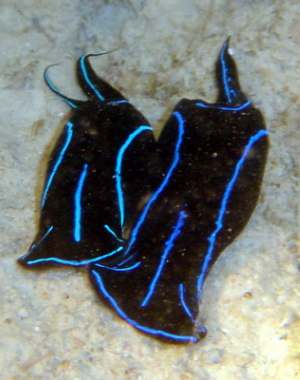
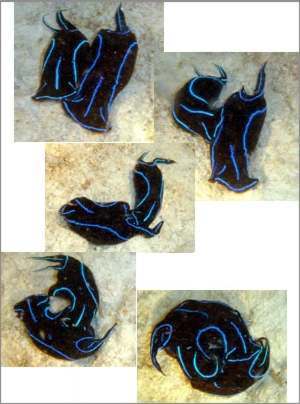
Dear Bill,
Here is another beauty for identification.
Location: Lankayan, Sabah, Malaysia
Depth: 12m or so
Bottom contour: Sandy
Taken by: Lim Eng Hoo
Thanx!
Asther
alau425@hotmail.com
Dear Asther,
Thanks for these photos of Chelidonura varians. I like the 'mating dance' you have compiled in the lower photo. I see the filename on the images you sent inclyuded 'flat worm'. They do indeed look quite like a small flatworm, and in the sandy regions they are found, small flatworms are often found. Species of Chelidonura in fact feed on flatworms, and aquarium keepers regularly ask me how they can obtain some Chelidonura to rid their aquariums of infestations of flatworms.
Best wishes,
Bill Rudman
Re: Chelidonura varians - shipping stresses?
June 25, 2003
From: James Urquhart
I hope you didn't take offense to the post. I understand your frustration. The animal in question is a true brittlestar and your statement about it exclusively feeding on small specs of detritus isn't quite accurate. Brittlestars will eat meat. They'll grab hold of a large chunk of shrimp and bring it with them to their hiding spot.
Thanks for the words of good luck and the information on their defenses. I'll look out for him and hope he turns up.
Thanks.
James Urquhart
james.urquhart@nautica.co
Dear James,
I have a lot of messages from aquariists, many of them which I am unable to post as they would completely clog up the Forum. There are some good general books readily available but many, not including you, don't seem to make any effort to find out about the animals they have in their care or are misled by those in the trade who sell animals to them. Concerning brittle star feeding, I am not an expert. Most are particle feeders and I guess they treat a hunk of shrimp as a very large particle. I'm not sure how they eat it as my understanding is that unlike starfish, which evert their stomachs out over their food, in brittle stars the food is ingested by ciliary movement. The point I was making is that I don't think your Chelidonura is in danger from the brittle star.
Best wishes
Bill Rudman
Re: Chelidonura varians - shipping stresses?
June 24, 2003
From: James Urquhart
Bill,
Thank you for your soapbox wisdom. I agree that your stance is the right way to be and think that it's admirable. Unfortunately, I am now reading your response because a second set of these wonderful creatures that should be left in the wild were shipped to me.
Fortunatly, they are alive and have acclimated well. My question is in regards to their toxin. I noticed my brittlestar take hold of one of them and scurry under the rocks. I have no idea if he consumed the creature and was curious whether or not the nudi would be something that the brittlestar could tolerate?
Any thoughts?
James Urquhart
james.urquhart@nautica.com
Dear James,
Concerning my 'soapbox wisdom'. If you received the 100s of messages I do - few of which I post on the Forum - I think you would be a bit exasperated as well. Reefs are being destroyed so a few people in rich countries can have a novelty. It's not much different from the end of the 1800s when a collection of 'naturally arranged' stuffed birds in a glass container was all the rage. It might have been nice for those who had one but it almost sent many species of humming birds extinct!
My first advice to all those who want to keep invertebrates in their tanks is to buy a book on the biology of marine invertebrates and learn something about their biology. Look for a book that has some background information not a book just with colour pictures, names and no information. Hopefully it would cut down quite a few general queries to the Forum. For example, if your animal is a brittle star, it would not have been attacking the Chelidonura, because all brittle stars are particle feeders, eating small specks of detritus they pick up with their tube feet. We don't know much about aglajid defences. They have a Yellow secretion but I don't think it is defensive.
I am not against people keeping aquaria, but I think the aquarium community has to take responsibility for the way the tropical reefs of the world are being wrecked to service the trade. Only buy captive bred animals and don't buy and keep animals which have no chance of surviving. Good luck with your Chelidonura
Bill Rudman
Chelidonura varians - shipping stresses?
May 28, 2003
From: James Urquhart
I recently purchased 2 Chelidonura varians or whatever they are calling "velvet seaslugs". They were shipped in the same bag and the water seemed somewhat tinted black. I followed a slow acclimation procedure and noticed NO movement on either slug. Both were very flat and seemingly devoid of blue strips.... Put them in the tank and subsequently one went drifting behind the rocks, the other went drifting off behind some other rocks...
Any words of wisdom with these? I was told by someone else I asked on another board that they could potentially release toxins when stressed and that shipping 2 together is not good...
Thanks in advance for you help.
James.
james.urquhart@nautica.com
Urquhart, J., 2003 (May 28) Chelidonura varians - shipping stresses?. [Message in] Sea Slug Forum. Australian Museum, Sydney. Available from http://www.seaslugforum.net/find/10051Dear James,
Sounds like they were dead on arrival - which I am afraid is not surprising. The water was apparently tinted black from the pigment released from the skin when the body began to break down. What killed these animals was humans not toxins released due to stress. Sea Slugs are very sensitive to changes in water chemistry, and to heat and cold etc. To ship them in small plastic bags around the world is irresponsible. To trade in them when we know that 99% will die from physical shock or starvation is criminal. While I have some sympathy for the poor villagers in 3rd world countries who wreck their environment to collect specimens to sell to relatively rich aquarium owners in the developed world, I have little sympathy for the dealers who make huge profits as middlemen. The only way to stop the trade is to encourage aquarium owners like you from buying this stuff. If you don't buy it the middlemen can't make a profit. Even the collection of such apparently harmless stuff as 'live rock' is causing huge damage to tropical shores. After all it is the very stuff which makes the reefs and the rocky shores and provides the home for countless plants and animals. How many thousand die each time a 'live rock' is hammered or dynamited off the shore. There is nothing wrong with keeping an aquarium, but try an restrict your plants and animals do those that are bred in captivity. Your aquarium should remind you of the beauty you can find in the sea, not be the last surviving remnant of a beauty that can no longer be found in the sea.
Best wishes,
Bill Rudman
Re: Chelidonura varians - trailing behaviour
May 21, 2003
From: Roberto Sozzani
Dear Bill,
In my recent message I forgot to say that mating went on for at least 4 minutes, before that cold and strong current rolled (really, like a wheel!) them away. So, mating was interrupted. I looked carefully where the two animals were mating and I could see some very small, jelly-like, transparent material. But not yet eggs inside. I think they just started pruducing something when they were interrupted.
Roberto Sozzani
roberto.sozzani@fastwebnet.it
Sozzani, R., 2003 (May 21) Re: Chelidonura varians - trailing behaviour. [Message in] Sea Slug Forum. Australian Museum, Sydney. Available from http://www.seaslugforum.net/find/10003Thanks Robert,
Bill Rudman
Re: Chelidonura varians - trailing behaviour
May 20, 2003
From: Roberto Sozzani
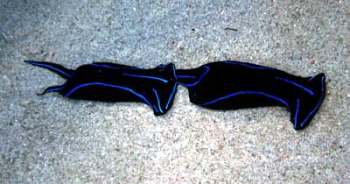
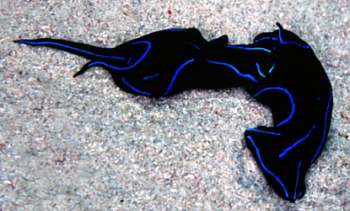
Dear Bill,
I have these 3 photos about Chelidonura varians trailing and mating. I was waiting for them to lay eggs, but a sudden cold current rolled them apart. Trailing lasted about 5 minutes. I hope this can be of some interest.
Location: Alor Is. (Indonesia)
Depth: 20 meters
Date: Feb. 2003
Roberto Sozzani
roberto.sozzani@fastwebnet.it
Sozzani, R., 2003 (May 20) Re: Chelidonura varians - trailing behaviour. [Message in] Sea Slug Forum. Australian Museum, Sydney. Available from http://www.seaslugforum.net/find/9998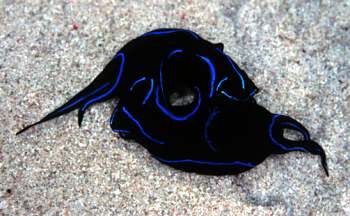
Thanks Roberto,
This is a nice complement to Leanne & David's message. It certainly supports my comment that 'trailing' in aglajids is often a prelude to mating. I am not sure how long after mating they are ready to lay eggs, but I suspect it may not be right away. All behavioural observations like this are very welcome.
Best wishes,
Bill Rudman.
Chelidonura varians - trailing behaviour
May 19, 2003
From: Leanne & David Atkinson
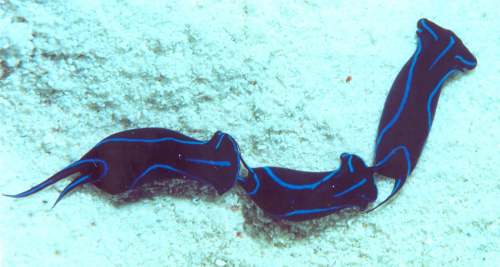
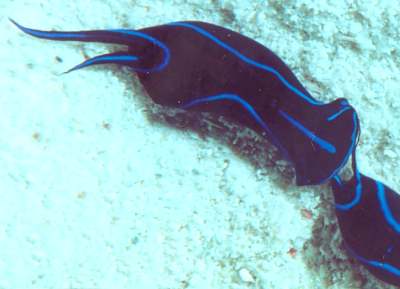
Dear Bill,
Can you help us identify these creatures which we think are Chelidonura varians. They were exhibiting trailing behaviour.
Location: Mana Passage, Mana Island, Fiji.
Date: April 2002, Daytime. Depth: 12m
Water Temperature: 30 degrees celsius
We also tried to video them but they quickly separated when the 100 watt movie light was turned on.
Thanks,
Leanne & David Atkinson
atk@hunterlink.net.au
Atkinson, L. & Atkinson, D., 2003 (May 19) Chelidonura varians - trailing behaviour. [Message in] Sea Slug Forum. Australian Museum, Sydney. Available from http://www.seaslugforum.net/find/9980Dear Leanne & David,
Yes this is Chelidonura varians and thanks for the nice photo of them trailing. As I mentioned in Stuart Hutchinson's message, trailing in aglajids is often a prelude to mating. They use their sensory bristles on either side of the mouth to follow the mucus trail of other animals. If they are the same species they often mate. See the C. inornata Fact Sheet for a photo of the sensory bristles.
Best wishes,
Bill Rudman
Chelidonura varians egg laying
April 22, 2003
From: Joe Yaiullo
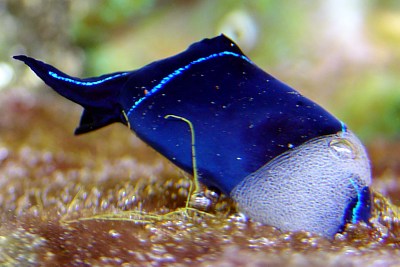
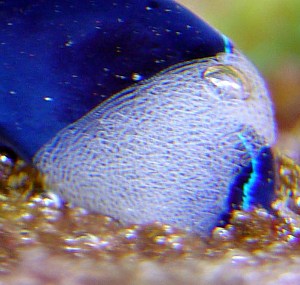
Bill,
Following my last message - I don't know if you need it but here is a photo of Chelidonura varians laying an egg mass on the side wall of a holding tank which is attached to the 20,000 gallon reef tank.
Joe Yaiullo,
Atlantis Marine World, NY.
justjoe63@aol.com
Yaiullo, J., 2003 (Apr 22) Chelidonura varians egg laying. [Message in] Sea Slug Forum. Australian Museum, Sydney. Available from http://www.seaslugforum.net/find/9667Thanks Joe,
Photos of sea slugs 'doing things' are always welcome. I must say I have nver worked out how the aglajid egg mass seems to end up a single sphere. As your photo shows, they always seem to make the egg mass by wrapping it around their head in this way - apparently producing a dough-nut shape.
Cheers,
Bill Rudman
Chelidonura varians - larval culture
April 9, 2003
From: Joe Yaiullo
I am looking for some help in rearing some Chelidonura varians. I have several breeding and laying egg masses. From the size of the eggs, I'm guessing they are going to be planktonic and I'm looking for a possible food source for them. Any suggestions would be greatly appreciated.
Sincerely,
Joe Yaiullo
Atlantis Marine World Aquarium, NY
justjoe63@aol.com
Dear Joe,
I guess you are hoping to supply the aquarium trade with Chelidonura varians as the answer to flatworm infestations. Good Luck! Looking after veliger larvae is not that easy, as in aquarium conditions they often succumb to infections or get stuck in the surface film. Apart from those sort of problems there are the problems of meeting the basic biological requirements of the larvae. You would need to find a source of appropriate unicellular algae for them to eat, and you would also need to know what triggers their metamorphosis - that is their change from a free-swimming veliger larvae to a small bottom-crawling slug. It may be the smell of their post-larval food, but I'm afraid we can only guess that that will be a very small flatworm. Have a look at my reply to a similar query about Navanax. I refer there to a paper by Paige. It's on aplysiids (sea hares) but I guess the principle is the same.
Good Luck,
Bill Rudman
Chelidonura varians from Lord Howe Island
January 9, 2003
From: W.B. Rudman
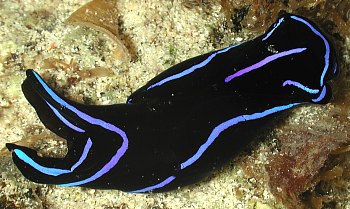
Here is a photo record from Ian Hutton of Chelidonura varians from Lord Howe Island.
Location: Far Rocks
Bill Rudman
Rudman, W.B., 2003 (Jan 9) Chelidonura varians from Lord Howe Island. [Message in] Sea Slug Forum. Australian Museum, Sydney. Available from http://www.seaslugforum.net/find/8779Chelidonura varians - Mabul Island, Malaysia
September 3, 2002
From: Richard Houghton
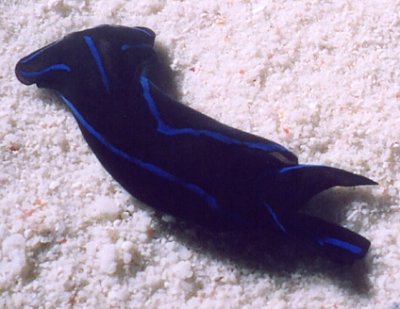
I feel fairly confident that this is Chelidonura varians after seeing your other photo's.
This one was found on a night dive crawling slowly along the sandy bottom at about 7 metres, off Mabul Island, Malaysia. In the 10 minutes we watched, it did not eat anything.
Best regards,
Rich
richard_houghton@hotmail.com
Houghton, R., 2002 (Sep 3) Chelidonura varians - Mabul Island, Malaysia. [Message in] Sea Slug Forum. Australian Museum, Sydney. Available from http://www.seaslugforum.net/find/7853Thanks Rich,
Yes this is C. varians.
Best wishes,
Bill Rudman
Aquarium flatworm control
April 3, 2002
From: Victor Hernandez
I've had a salt water tank for a couple years now and noticed for the first time today Acoel Flatworms colonizing my disc anemones. I read an article in a publication called Marine Fish and Reef, (Annual 2000) indicating that if the flatworms are left in the absence of predators they can become a problem.
I went on to read that Sea Slugs of the genus Chelidonura are known to feed on them, as I also saw in a photo here on your site. Are these sea slugs an importable creature in the aquarium hobby or not? And if so what is the longevity of such a creature in captivity? Will Chelidonura deplete its food source quicker than the flatworms reproduce?
I would appreciate whatever input you could provide. I don't want to import an animal that will not be successful in a reef aquarium.
Victor Hernandez
Victor.s.hernandez@bankofamerica.com
Hernandez, V., 2002 (Apr 3) Aquarium flatworm control. [Message in] Sea Slug Forum. Australian Museum, Sydney. Available from http://www.seaslugforum.net/find/6655Dear Victor,
Chelidonura varians is the species normally mentioned. Have a look at the messages on that page for a full discussion on its efficacy. Basically, they are hard to obtain, we know nothing of their life-history in the wild, so we have no idea how long they would last in an aquarium. If you got one, I see no reason why it wouldn't just eat all your flatworms and then starve to death. I am afraid its brain is a bit small to know about rationing its food supply.
Cheers,
Bill Rudman
Chelidonura varians from Indonesia
March 9, 2002
From: Stuart Hutchison
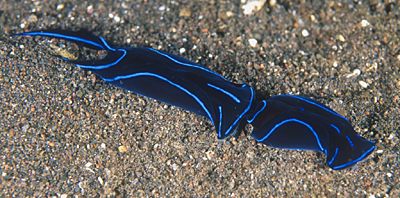
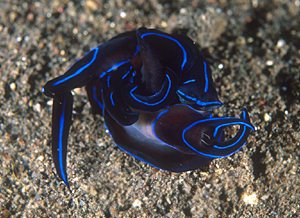
Hi Bill,
Here's some shots of Chelidonura varians from Bali, Indonesia on 16 Oct 2001. Lengths 35mm. Depth 14m.
Regards,
Stuart
stuart@stuarthutchison.com.au
Hutchison, S., 2002 (Mar 9) Chelidonura varians from Indonesia. [Message in] Sea Slug Forum. Australian Museum, Sydney. Available from http://www.seaslugforum.net/find/6299Dear Stuart,
Thanks for these nice photos showing two animals making contact and beginning to mate. Just seeing these photos will send those with an infestation of flatworms into a frenzy.
Cheers,
Bill Rudman
Re: Slug to control photosynthetic flatworms
March 9, 2002
From: Patrick Webb
Hello,
I live in Monroe, Michigan, USA and I am running the eco system filter with the caulurpa. I am infested with what I believe is red Planaria, which was introduced into my tank with the caulurpa. (Thanks buddy) lol. I have had this system for about 1 yr total run time and I have done everything I know how to do to eradicate the flatworms to include fresh water dip, mandarins, green chromis, and a six line wrasse. The pet shops just sold me a bunch of fish that was not interested in eating the flat worms. I have searched hi and low for the slug and I have watched the price of this slug skyrocket in the last 4 months, from 6 dollars to 28 on one site, and from 18 dollars to 50 dollars on another with no promise of live arrival. Is there anybody, anybody that can help me with this. I have corals, and inverts, so the suicidal conconction that one person wrote about using (CLOUT) I am not interested in trying.
Thanks
Patrick
hick11h1369@tm.net
Webb, P., 2002 (Mar 9) Re: Slug to control photosynthetic flatworms. [Message in] Sea Slug Forum. Australian Museum, Sydney. Available from http://www.seaslugforum.net/find/6365Dear Patrick,
I'm sorry but I can't post all the messages I get from aquarium enthusiasts with flatworm and Aiptasia problems in detail. I have more than enough messages dealing directly with slugs. The problem with using Chelidonura is that they are not overly common in nature and I know of no-one who has been able to breed them in captivity and I suspect they are relatively short-lived. Quite a different situation than using Berghia verrucicornis for Aiptasia.
I am amazed at the price rise in the cost of Chelidonura but I guess that is how capitalism works. My feeling with aquaria is that disasters, although distressing, are part of the experience - and often there is no easy solution to a problem. One important lesson learnt is that new additions to an aquarium should be quarantined for some time before being introduced to your main tank. If your Caulerpa had been in a quarantine tank then you would probably have seen the flatworms. Sorry I can't provide an instant solution
Best wishes,
Bill
Re: Slug to control photosynthetic flatworms
January 25, 2002
From: Mark
Re: Slug to control photosynthetic flatworms message:
Not related to slugs of any sort, but rather the flatworms; scooter blennies eat them up like california rolls.
Mark
caesar@umich.edu
Mark, 2002 (Jan 25) Re: Slug to control photosynthetic flatworms. [Message in] Sea Slug Forum. Australian Museum, Sydney. Available from http://www.seaslugforum.net/find/6084Thanks Mark,
'scooter blennies' are obviously a type of fish and I guess 'california rolls' are some west coast culinary delight. If the blennies are easily obtainable, and will eat other things as well, its sounds as though they are a much more practical way of controlling flatworms in aquaria than trying to find specimens of Chelidonura which will starve after cleaning up the flatworms and probably live for less than a year anyway.
Cheers,
Bill Rudman
Re: Need Slug that will help with Flatworms
September 7, 2001
From: joe
hi did you manage to find out where to obtain these worms????????,i could do with some myself i live in birmingham u.k
Joe
shrimpan@lineone.net
joe, 2001 (Sep 7) Re: Need Slug that will help with Flatworms. [Message in] Sea Slug Forum. Australian Museum, Sydney. Available from http://www.seaslugforum.net/find/5050Dear Joe,
I guess you are after Chelidonura varians. Have a look on that page because I think there are a couple of messages mentioning places that supply it, including Gary Robinson's. However unless the supplier is breeding them, I doubt if they will have a regular supply, and unfortunately for you they are in the USA.
Best wishes,
Bill Rudman
Slug to control photosynthetic flatworms
September 7, 2001
From: Darrell Gibson
I am looking for a slug which preys on the photosynthetic flatworms which are taking over my aquariums. Many weeks ago I located a slug called "Black Velvet Slug" on one of the retail saltwater websites which was purported to eat the photosynthetic flatworms. The picture showed a black slug with blue stripes. I have since misplaced the url for the site. Please, does anyone know where I could obtain this so-called Black Velvet Slug or another slug which would help control the flatworms?
Darrell Gibson
jongleurdg@earthlink.net
Gibson, D., 2001 (Sep 7) Slug to control photosynthetic flatworms. [Message in] Sea Slug Forum. Australian Museum, Sydney. Available from http://www.seaslugforum.net/find/5216Dear Darrell,
I guess you are after Chelidonura varians. Have a look on that page because I think there are a couple of messages mentioning places that supply it, including Gary Robinson's. However unless the supplier is breeding them, I doubt if they will have a regular supply.
Best wishes,
Bill Rudman
Need Slug that will help with Flatworms
June 17, 2001
From: D. Scott Morrison
I have recently set up a reef tank in my office and have unfortunately had to rip it down because of a plague of planaria flatworms. I dipped the rock and coral in fresh water and filtered off the carcasses of the little buggers. Upon settling I have noticed that we didn't get them all. Before they grow back to similar preportions I have benn told that there are slugs out there that eat these little monsters! Does anyone out there know of the truth to this tale and if it is true
1. What slugs are available?
2. Are they available for the hobby?
3. If so, how do I get ahold of some?
If there are any of you out there with some or all of these answers could you please drop me a e-mail.
Thank you
Dr. D. Scott Morrison
doctorscott@telus.net
Morrison, D.S., 2001 (Jun 17) Need Slug that will help with Flatworms. [Message in] Sea Slug Forum. Australian Museum, Sydney. Available from http://www.seaslugforum.net/find/4470Dear Scott,
The animal you need is Chelidonura varians. Have a look at some of the attached messages below yours on this page and you will find information, and I think some places in the US where they can be bought. I suspect any species of Chelidonura would do the trick.
Best wishes,
Bill Rudman
Juvenile Chelidonura from SE Sulawesi
June 13, 2001
From: Lindsay Warren
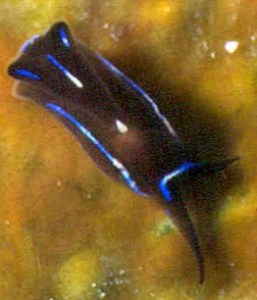
Dear Bill
This Chelidonura (OWN114) was found by Doug Philpott at 4pm on 15 June 1999
at a depth of 9 m on sand on a wall of Pulau Hoga [Tukang Besi Archipelago, SE Sulawesi, Indonesia - Operation Wallacea]. Size: 4 mm.
The overall body colour is dark brown with irridescent blue and white edges to the parapodia. Similar thin irridescent lines are on either side of the head, one in the centre and at the rear between the two tails. There is also a small white patch halfway down the notum. Photo: Lindsay Warren.
Do you know which species it might be?
All the best
Lindsay Warren
alldcl@compuserve.com
Warren , L., 2001 (Jun 13) Juvenile Chelidonura from SE Sulawesi. [Message in] Sea Slug Forum. Australian Museum, Sydney. Available from http://www.seaslugforum.net/find/4531Dear Lindsay,
I am pretty certain that it is a juvenile of Chelidonura varians. All the colour markings are consistent.
Best wishes,
Bill Rudman
Planaria-eating nudibranch?
April 2, 2001
From: Drew Dram
Have you ever heard of a sea slug called the varians nudibranch? I have no further information on it other than it is black with two blue lines on the top of it and it the supposedly eats flatworms (Planaria), an eyesore to the marine aquarium that eventually becomes plague proportions. These flatworms do not harm many corals but most times they cover all the live rock in the aquarium and spread rapidly throughout the aquarium.These worms are nearly impossible to get rid of without using harmful chemicals in the reef aquarium that are detremental to fish and corals. Thre are few fish that eat these worms and when the planaria are in tremendous amounts the fish will not eat them because of the over-population. I have tried thirty second dips in reverse osmosis water and that causes the planaria fall off and die in the fresh water. So, now I can control them by not bringing them into the aquarium but I cannot control the ones in the aquarium. I am sorry I do not know where the nudibranchs come from but I do know that Planaria comes from Indonesia, and it is most often spread through the aquarium trade by way of wholesalers and retailers that have had it in their tanks.
Drew Dram
thomdram@earthlink.net
Dram, D., 2001 (Apr 2) Planaria-eating nudibranch?. [Message in] Sea Slug Forum. Australian Museum, Sydney. Available from http://www.seaslugforum.net/find/4107Dear Drew,
The slug your are interested in is Chelidonura varians. If you look at the information and messages above and below your message you will get quite a bit of background information about this interesting slug. It is not a 'nudibranch'. Nudibranchs are just one group or Order of Sea Slugs (Opisthobranchs). Chelidonura varians belongs to the order Cephalaspidea, which are commonly called Bubble Shells, because many have large bubble-shaped shells. If you have a look at the Species List you will see there are quite a few Orders of Sea Slugs. If you look at some of the species listed under each order you will get an idea of the great diversity found amongst the Sea Slugs.
Concerning where you can get some Chelidonura for your aquarium. Personally I think these animals are better left in their natural habitat. If collected, I suspect most will die in transit, and even if they survive they are unlikely to breed in captivity. If you have some other method of controlling flatworms, such as dipping in freshwater, I would suggest you continue to use that. The other thing to remember is that although the flatworms are a pest in aquaria, they are a natural part of the tropical environment, and certainly weren't asked to make the trip from the tropics to some aquarium in the city.
Best wishes,
Bill Rudman
Chelidonura feeding observations
December 22, 2000
From: Julian Sprung
Dear Bill,
I was the aquarist/author to point out that Chelidonura varians eats the red acoel flatworms in aquariums. You can see my photos of this in the book The Reef Aquarium, Vol. 2.
They don't actually open and eat the contents of the worms as was mentioned by some observers. They literally suck them up like a vacuum. The stick out a proboscis that rapidly sucks them in. It is amazing to watch them "track" the worms and also it is remarkable that their shape essentially mimics the outline of the flatworms that they eat!
Best Regards,
Julian Sprung
julian@twolittlefishies.com
Sprung, J., 2000 (Dec 22) Chelidonura feeding observations. [Message in] Sea Slug Forum. Australian Museum, Sydney. Available from http://www.seaslugforum.net/find/3354Dear Julian,
Your observations fit with their anatomy. Species of the genus Chelidonura have a small muscular buccal bulb, similar in structure if not in relative size, to the buccal bulb of Melanochlamys which feed on polychaete worms by rapidly sucking them in like a piece of spaghetti.
Julian's book that features a page showing Chelidonura varians eating flatworms
is:
Sprung, J. and Delbeek, J.C. (1996) The Reef Aquarium Volume Two: A Comprehensive Guide to the Identification and Care of Tropical Marine Invertebrates. Ricordea Publishing, Inc. Coconut Grove, Florida. USA
ISBN # 1-883693-13-6
French (ISBN 1-883693-20-9)
German (ISBN 3-921684-45-5)
Best wishes,
Bill Rudman.
Re: Where to get Chelidonura varians
June 10, 2000
From: Scott Crumpton
Any new news on the slug [Chelidonura varians] which eats Acoel Flatworms and where to obtain one?
Thanks,
Scott
public@moriah.com
Crumpton, S., 2000 (Jun 10) Re: Where to get Chelidonura varians. [Message in] Sea Slug Forum. Australian Museum, Sydney. Available from http://www.seaslugforum.net/find/2540Dear Scott,
Did you see Gary Robinson's message with a supplier in the USA. depending om where you live that may be of help to you.
I guess any species of Chelidonura would do the job but I don't know of any other supplier. Unless you live in the tropical Indo-West Pacific, finding your own may be a problem.
Did you see Akos Lumnitzers' recent photo of a lucky Chelidonura inornata with a whole aggregation of flatworms.
Best wishes,
Bill Rudman.
Re: Where to get Chelidonura varians
February 14, 2000
From: Gary J. Robinson
I have discovered that Inland Aquatics is now selling this creature [Chelidonura varians] and I intend to get some to eradicate my plague of red flatworms.
There is an incredible paucity of information regarding aquarium care of this species. I have spoken to one person who used them to clean up his tank and he said the key was to turn off all powerheads and pumps and just rely on airstones for circulation. Apparently the little slugs get sucked into pumps and killed which is why they tend to "disappear" shortly after being released into circulation-heavy reef tanks. This gentleman reports it took several weeks for the slugs to do the job on his flatworm infestation, assisted by siphoning and a wrasse. Since everyone around here has flatworms, I figure a slug can be passed around from tank to tank on clean-up duty - if it survives. It will probably die of old age before it runs out of flatworms to eat in this town.
In any case an interesting article just appeared on easy mariculture of Berghia nudibranchs, at http://www.reefs.org, indicating they can even be raised in a jar and introduced to the aquarium as needed. I think I will order a pair of C. varians and see if such a thing is possible with them as well. It is easy enough to siphon flatworms and put them in the jar as food. Alternately I might try breeding a pair in my tank's refugium and letting them migrate to the rest of the tank. The refugium has very low currents so they should not get sucked into the overflow. I could even disable the refugium circulation and replace it with an airstone. I will report back on my experiments. At this point I have no idea of their reproductive behavior or cycle.
Gary J. Robinson
twisk@tlh.fdt.net
Robinson, G.J., 2000 (Feb 14) Re: Where to get Chelidonura varians. [Message in] Sea Slug Forum. Australian Museum, Sydney. Available from http://www.seaslugforum.net/find/1881Dear Gary,
Thanks for the interesting information and please keep us informed of your experiments. We don't know much about the life-cycle of any of the species of Chelidonura but from the size of their eggs I would suspect they have planktonic larvae which will need to feed for some time before settling down to grow into crawling slugs. If you have plenty of flatworms, keeping the larvae alive will be the critical stage I would suspect. Have a look at Mary Jane Adams photo of the egg masses of Chelidonura so you know what to look for if your animals decide to breed.
Best wishes,
Bill Rudman.
Re: More on Chelidonura feeding
February 8, 2000
From: Cory Pittman
Dear Dr. Rudman,
I thought you might like an update on Chelidonura feeding (however belated). During my last couple of trips to Maui, I've replicated the observations of Chelidonura fulvipunctata and C. hirundinina several times with the same results. In addition, I've offered Convoluta sp. several times to an unnamed species of Chelidonura that's also common in the same habitat. That species has a much slower feeding strike than the other two allowing the details to be easily seen. The pharynx is everted sufficiently to form a short tube and the worm is sucked in "spaghetti-fashion". It strikes immediately on contact with the worm and shows no sign of regurgitation or rejection (unlike C. fulvipunctata which engulfs, then regurgitates and C. hirundinina which tests, then rejects). It's my subjective impression that the worms show a stronger aversive response to contact with Chelidonura sp. than with the other two. Additionally, Chelidonura fulvipunctata is nocturnal while C. hirundinina, Chelidonura sp. and Convoluta sp. are active during the day. So, there's a good chance that Chelidonura sp. is the one that actually feeds on Convoluta sp. in the field.
By the way , Terry Gosliner reported C. hirundinina feeding on acoel flatworms in Coral Reef Animals of the Indo-Pacific, 1996 (and, I believe, elsewhere) prior to my first message (something I didn't recall when I sent it). So, he should be credited with the first observations in that regard.
Best wishes,
Cory Pittman
cory@cet.cet.com
Pittman, C., 2000 (Feb 8) Re: More on Chelidonura feeding. [Message in] Sea Slug Forum. Australian Museum, Sydney. Available from http://www.seaslugforum.net/find/1870Dear Cory,
Thanks for the further information. I only saw a copy of the Coral Reef Animals book late last year and must admit to not noticing the reference to C. hirundinina feeding on Convoluta. I had a quick scan of the literature this morning and note that Terry also mentioned C. hirundinina "feeding on small flatworms" in his South African book which I had certainly not noticed.
Although not first, your observations are very valuable in helping to show that Terry's species specific observation, can probably be applied to the whole genus.
Thanks again,
Bill Rudman.
A nudibranch that eats Flat Worms
December 10, 1999
From: john
Hi,
Does anyone know of a nudibranch that is available in pet stores that will eat planaria?
thanks
john
hampton_john@hotmail.com
Hampton, J., 1999 (Dec 10) A nudibranch that eats Flat Worms. [Message in] Sea Slug Forum. Australian Museum, Sydney. Available from http://www.seaslugforum.net/find/1665Dear John,
I guess this means you have flatworm problems in your aquarium. Have a look at my answer to Roger's message, which I think was the last on the topic to reach the Forum. Also look at the other messages, below yours, on this page which also discuss aspects of the same topic.
Best wishes,
Bill Rudman.
control of flatworms in marine aquarium
May 29, 1999
From: Roger
I recently started a reef aquarium and have just discovered a large number or red flatworms on the glass. One reference book describes the type of worm as Convolutriluba and says it can multiply and suffocate my coral life. How can this be controlled or eliminated? Are there chemical treatments, natural predators or other solutions?
Roger
Roger-jeff@msn.com
Dear Roger,
I am not an aquarium expert, but there are many small flatworms which will eat corals sponges and soft-corals. One genus of sea slugs (Chelidonura) love to eat these flatworms but the sea slugs unfortunately are not commercially available and are not abundant enough to commercially 'fish'. Have a look at the page on Chelidonura varians for some background information on one of the slugs, and look at some of the previous messages, which are below your message on the page, for some of the discussion which has already occurred.
Best wishes,
Bill Rudman.
Red flatworm-eating Sea Slug
April 14, 1999
From: pat
Can someone help me locate a sea slug that eats red flat worms,,that is reef aquarium safe
pat
gilrane@plexi.com
Dear Pat,
There has been quite a discussion in the Forum on species of Chelidonura feeding on flatworms, especially Chelidonura varians. Have a look above your message for a picture of Chelidonura, and below your message for earlier discussion on the subject. Basically there doesn't seem to be any commercial supply for these animals.
Best wishes,
Bill Rudman.
Re: Where can I get Chelidonura varians?
March 29, 1999
From: Donna Stimetz
Was there ever any dealer found in the U.S. who carried C. varians? I'm looking for some too. If anyone has any idea where I might obtain one I'd be very very happy!!!!!!
DonnaS3@aol.com
Stimetz, D., 1999 (Mar 29) Re: Where can I get Chelidonura varians?. [Message in] Sea Slug Forum. Australian Museum, Sydney. Available from http://www.seaslugforum.net/find/728Where can I get Chelidonura varians?
November 30, 1998
From: Paul Hranitz
Greetings,
I am a reef hobbiest in search of the nudibranch, Chelidonura varians, which is a striking color of black with electric blue stripes. My dilemma, flatworm infestation. My understanding is that this particular Nudibranch loves to munch on these critters. Does anyone have any info on where these can be purchased, preferrably a US based aquatic dealer. Any help greatly appreciated...thanks,
Paul Hranitz
phranitz@us.ibm.com
Hranitz, P., 1998 (Nov 30) Where can I get Chelidonura varians?. [Message in] Sea Slug Forum. Australian Museum, Sydney. Available from http://www.seaslugforum.net/find/344Dear Paul,
Clearly you aquarium keepers must all be reading the same book. Have a look at the other messages below on this page discussing this very question. At the top of the page you will find a picture of the animal in question. Personally I would prefer that Chelidonura was left to live out its life where it was meant to .. on the tropical reefs of the Indo-West Pacific.
The problem with having a flatworm "muncher" to clean up your tank means that it starves after it has done its job! Or are you hoping they will strike a happy balance. Sorry, but I have no idea where you could get a regular supply of Chelidonura, although reasonably common, I doubt if a supplier could guarantee to find them on demand. If anyone can help perhaps they could let Paul know.
At the risk of being "picky", Chelidonura is not a nudibranch. It is definitely a Sea Slug, but not all Sea Slugs are nudibranchs. Sea Slugs (or "opisthobranchs"), include the Order Nudibranchia, the Order Cephalaspidea,(or Bubble Shells), to which Chelidonura belongs, and other orders such as the Anaspidea (Sea Hares) and the Sacoglossa, which don't have a widely accepted common name.
Bill Rudman.
Rudman, W.B., 1998 (Nov 30). Comment on Where can I get Chelidonura varians? by Paul Hranitz. [Message in] Sea Slug Forum. Australian Museum, Sydney. Available from http://www.seaslugforum.net/find/344Chelidonura feeding
October 14, 1998
From: Davide & Giovanni
Hello to you again Mr. Rudman!
Answering to your question we are two students working on our University "tesi" (it.) on hard corals at Genova Aquarium. Our names are Davide Giovine and Giovanni Raimondi. I'm Davide and I am "the one who is able to use computers" and last time I did not mentioned Giovanni only because I was in a hurry (as usual) and I forgot him.
Thank to your forum Mr Koehler wrote us from Germany and told us that he would be probably able to send us some Chelidonura in November.. we hope so!
Thank you again.
Bye.
Davide and Giovanni.
davidegiovine@yahoo.com
Giovine, D. & Raimondi, G., 1998 (Oct 14) Chelidonura feeding. [Message in] Sea Slug Forum. Australian Museum, Sydney. Available from http://www.seaslugforum.net/find/259Thanks for the background information. I am sure it will be of interest to participants..(and it sorted out my confusion between Davide Giovine and Davide & Giovanni.... Bill Rudman
Reference for Chelidonura feeding
October 8, 1998
From: Davide Giovine
Dear Mr Rudman
I've already posted to you the exact title. Probably I'm not such able as I think with E-mail. Hope this time will go better.
The book is:
Sprung J. & J.C.Debeek
The Reef Aquarium vol.2 - 1997
and at the page 427 you will find informations about Chelidonura.
Regards,
Davide
Davide Giovine
davidegiovine@yahoo.com
Giovine, D., 1998 (Oct 8) Reference for Chelidonura feeding. [Message in] Sea Slug Forum. Australian Museum, Sydney. Available from http://www.seaslugforum.net/find/250Dear Davide,
Thanks for the reference. Your earlier email must have got lost. ... Bill Rudman
More Chelidonura feeding
October 7, 1998
From: Cory Pittman
Dear Dr. Rudman,
I read your request for observations of Chelidonura feeding behavior shortly after returning to Hawaii for my fall collecting session. That started me thinking about it and, since I often find both small Chelidonura spp. and small flatworms while sorting algae washes, I thought I'd set up a few "encounters" and see what happened. :)
I added a pair of Chelidonura fulvipunctata (6 & 8 mm) to a small dish containing four 1.5-2 mm acoelamate flatworms of the species that Poulter tentatively identifies as Convoluta sp. in section two of Reef and Shore Fauna of Hawaii, 1987. Over a few minutes, I watched them eat three of the worms (the other "disappeared" when I wasn't looking). Their feeding reflex seemed quite extraordinary for an Opisthobranch. On contact with the sensory hairs, the worms were "inhaled" with a speed comparable to the feeding strike of a scorpion fish, i. e., much too fast to make out any details of the movement. So, they certainly responded to that species. Whether it's "on the menu" normally is still open to question, however, since (in at least two of the cases) they regurgitated the crushed remains of the worm about 15-20 seconds after taking it. It may be close enough to their normal prey to trigger their feeding reflex but proves unpalatable after ingestion (perhaps due to some defensive chemical?). Then, again, something else may have triggered regurgitation since my small, well-lighted dish differs considerably from their natural environment.
Later, I added another C. fulvipunctata to a dish with half a dozen 2 mm worms of a different, but undetermined, species. In that case, the Chelidonura totally ignored the worms through several "encounters".
I also offered Convoluta sp. to C. hirundinina with variable results. Most of the time, the Chelidonura ignored the worms. A couple of times, however, the worm was partially engulfed or "tasted" before being rejected. Once, it was completely "inhaled" with a speed comparable to the C. fulvipunctata trials then immediately "spit out", apparently unharmed. Perhaps, evolving an early rejection response to Convoluta sp. would make sense for C. hirundinina if the worm is toxic or distasteful.
I'll try a few more pairings as opportunity permits and see if I can find something that they'll "keep down". :)
By the way, over the years, I've seen many interactions between Chelidonura spp. and a wide variety of other organisms (mollusks, polychaetes, etc.) without triggering their feeding reflex.
I hope this is of interest. Best wishes for your recovery.
Sincerely,
Cory Pittman
temporarily from norm@maui.net
norm@maui.net
Pittman, C., 1998 (Oct 7) More Chelidonura feeding. [Message in] Sea Slug Forum. Australian Museum, Sydney. Available from http://www.seaslugforum.net/find/248Thanks for the observations Cory.
This is the sort of information which usually slips through the net. Not enough for a publication so what do you do with it? I had hoped the Slug Forum would become a place where we could share this sort of information and you contribution is a great example. As I will be leaving messages untouched (apart from correcting typos if I spot them) I see no reason why messages in the Forum cannot be cited in publications.
Your observation of the speed with which Chelidonura "inhales" its prey fits with its anatomy. Most species of the Aglajidae (except Odontoglaja guamensis) have a very modified foregut in which the radular teeth are lost. In species of Aglaja and most Philinopsis the buccal bulb is large and partially everts during feeding to envelop their prey (Bubble Shells and other opisthobranchs). In contrast, species of Melanochlamys and Chelidonura have a very rigid muscular buccal bulb which acts as a suction pump. I have watched Melanochlamys cylindrica in New Zealand sucking in polychaete worms at the blink of an eye .. much like eating spaghetti. I guessed species of Chelidonura, with a very similar shaped buccal bulb, would also suck in its prey and your observations certainly confirm that.
I'll post some more pictures of aglajids on the Forum in the near future. They are an interesting group. Thanks again for sharing your observations with us. ... Bill Rudman.
Rudman, W.B., 1998 (Oct 7). Comment on More Chelidonura feeding by Cory Pittman. [Message in] Sea Slug Forum. Australian Museum, Sydney. Available from http://www.seaslugforum.net/find/248Re: Chelidonura feeding
September 18, 1998
From: Peter Firminger
Having seen Bill's reply, I did a bit of a search and came up with the following reference..
Delbeek, J.C. & J. Sprung. 1994. The Reef Aquarium: a comprehensive guide to the identification and care of tropical marine invertebrates., Ricordea Publishing: Coconut Grove, FL.
I found this on http://www.aquarium.net/0297/0297_5.shtml
Regards,
Peter Firminger
peterf@austmus.gov.au
Chelidonura feeding
September 8, 1998
From: Davide & Giovanni
We have plenty of red Convolutria retrogemma (red flatworm) in our tank. J. Sprung says that the nudibranchs of the genus Chelidonura feed exclusively on acoel flatworms and C. varians feed on red flatworms. Can you tell us where we can find some of C. varians?
Thank you.
Davide & Giovanni.
28 August 1998
davidegiovine@yahoo.com
Giovine, D. & Raimondi, G., 1998 (Sep 8) Chelidonura feeding. [Message in] Sea Slug Forum. Australian Museum, Sydney. Available from http://www.seaslugforum.net/find/219Dear Davide & Giovanni,
I am very interested in your report that species of Chelidonura actually feed on flatworms. I have been trying to discover what they feed on for about 30 years! I have long suspected flatworms but have never actually caught them in the act and once the food begins to digest there are no recognisable remains in the gut. Is J.Sprung a friend or are you referring to a book? I would be most grateful for a reference to evidence of Chelidonura actually feeding on something.
As to where you can find Chelidonura varians. It is not the most common species, but is often reported from shallow sandy lagoons and pools on coral reefs in both the Indian and Pacific Oceans ... Bill Rudman.
Rudman, W.B., 1998 (Sep 8). Comment on Chelidonura feeding by Davide & Giovanni. [Message in] Sea Slug Forum. Australian Museum, Sydney. Available from http://www.seaslugforum.net/find/219